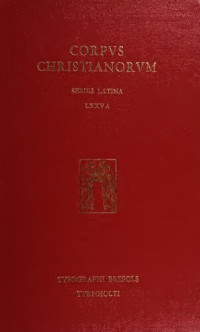
The Expositio super Danielem of Andrew of St. Victor : a critical edition together with a survey of the medieval interpretation of Daniel [PhD thesis]
Mark Allen Zier
Jerome's commentary on Daniel sets the tone in many ways for the medieval interpretation of Daniel. It is largely historical and philological in content because of Jerome's explicit purpose to refute the attack of the Neoplatonist Porphyry. Raban Maur (d.856) recopied the bulk of Jerome, inserting occasional comments frpin Ambrosiaster, Gregory, and Bede, and adding his own remarks.
In the 12th c. Gilbert Universal (d.1134) condensed and adapted Jerome's text to the exigencies of introducing students to the Bible. Gilbert's is the first such 'scnool text' and seems to have become the 12th c. Glossa Ordinaria for Daniel. The Expositio of Andrew of St. Victor (d.1175) provides a counterpoint to Jerome, dealing in depth with chronological obscurities passed over by Jerome, as at Dn 1.1, 2.1, 9.24-27, etc. His work also reflects his conversations with contemporary rabbis. Rashi and his school seem to be the ultimate sources for the Jewish opinions reported by Andrew. But most important to the Christian commentators of the next century was Andrew’s method of amplifying the text in order to bring out its nuances. The Histories of Peter Comestor (d.1180) seem to reflect some knowledge of Andrew's Expositio, though the commentaries on Daniel by Peter Cantor and Stephen Langton do not.
Joachim of Fiore (d.1202) introduces a new interpretation of Daniel that gradually grows in popularity, at least up to the time of Nicholas of Lyra. Joachim suggests that the historical meaning of the text is apocalyptic as early as the vision of Dn 8, the ram and the he-goat. Jerome had placed the apocalyptic emphasis only at Dn. 11.21.
Hugh of St. Cher (d.1263) represents a more historical approach to the text. His comments breath the spirit, of Andrew, whose Expositio he cites anonymously over 100 times. Hugh establishes the tradition of seeing the visions as ‘sacramenta’ of the events of Christ’s life. Albert the Great (d. 1280) follows Gilbert and Peter Comestor, pausing occasionally to discuss pastoral concerns such as penance. John de Murro (d.1313), who owned a manuscript containing most of Andrew's works, shows Andrew's care fdr the historical meaning of the text, but at the same time extends Joachim's apocalyptic understanding systematically to all the visions of Dn 7.12. John's work is admirably suited to the needs of preaching. Nicholas of Lyra (d.1349) draws on John's work, and displays an encyclopedic knowledge not
only of the Fathers, but also of the 13th c. scholastics. The tension between history and apocalyptic seems to have contributed to Lyra's development of a double-literal sense.
The present edition is based on three manuscripts: Cambridge, Pembroke College, MS 45 (early 13th c., Bury St. Edmund's), Paris, Bibliotheque nationale, MS lat. 574 (late 15th c., Naples), and Vatican City, Biblioteca Apostolica, MS Vat. lat. 1053 (late 13th c., Paris). The edition is prefaced by a thorough codicological investigation of both the contents and context of the manuscripts, and accompanied by an apparatus criticus and apparatus fontium.
In the 12th c. Gilbert Universal (d.1134) condensed and adapted Jerome's text to the exigencies of introducing students to the Bible. Gilbert's is the first such 'scnool text' and seems to have become the 12th c. Glossa Ordinaria for Daniel. The Expositio of Andrew of St. Victor (d.1175) provides a counterpoint to Jerome, dealing in depth with chronological obscurities passed over by Jerome, as at Dn 1.1, 2.1, 9.24-27, etc. His work also reflects his conversations with contemporary rabbis. Rashi and his school seem to be the ultimate sources for the Jewish opinions reported by Andrew. But most important to the Christian commentators of the next century was Andrew’s method of amplifying the text in order to bring out its nuances. The Histories of Peter Comestor (d.1180) seem to reflect some knowledge of Andrew's Expositio, though the commentaries on Daniel by Peter Cantor and Stephen Langton do not.
Joachim of Fiore (d.1202) introduces a new interpretation of Daniel that gradually grows in popularity, at least up to the time of Nicholas of Lyra. Joachim suggests that the historical meaning of the text is apocalyptic as early as the vision of Dn 8, the ram and the he-goat. Jerome had placed the apocalyptic emphasis only at Dn. 11.21.
Hugh of St. Cher (d.1263) represents a more historical approach to the text. His comments breath the spirit, of Andrew, whose Expositio he cites anonymously over 100 times. Hugh establishes the tradition of seeing the visions as ‘sacramenta’ of the events of Christ’s life. Albert the Great (d. 1280) follows Gilbert and Peter Comestor, pausing occasionally to discuss pastoral concerns such as penance. John de Murro (d.1313), who owned a manuscript containing most of Andrew's works, shows Andrew's care fdr the historical meaning of the text, but at the same time extends Joachim's apocalyptic understanding systematically to all the visions of Dn 7.12. John's work is admirably suited to the needs of preaching. Nicholas of Lyra (d.1349) draws on John's work, and displays an encyclopedic knowledge not
only of the Fathers, but also of the 13th c. scholastics. The tension between history and apocalyptic seems to have contributed to Lyra's development of a double-literal sense.
The present edition is based on three manuscripts: Cambridge, Pembroke College, MS 45 (early 13th c., Bury St. Edmund's), Paris, Bibliotheque nationale, MS lat. 574 (late 15th c., Naples), and Vatican City, Biblioteca Apostolica, MS Vat. lat. 1053 (late 13th c., Paris). The edition is prefaced by a thorough codicological investigation of both the contents and context of the manuscripts, and accompanied by an apparatus criticus and apparatus fontium.
หมวดหมู่:
ปี:
1983
สำนักพิมพ์:
University of Toronto
ภาษา:
english
จำนวนหน้า:
530
ไฟล์:
PDF, 20.16 MB
IPFS:
,
english, 1983
 Amazon
Amazon  Barnes & Noble
Barnes & Noble  Bookshop.org
Bookshop.org  สามารถแปลงไฟล์ได้
สามารถแปลงไฟล์ได้ ผลการค้นหาเพิ่มเติม
ผลการค้นหาเพิ่มเติม สิทธิประโยชน์อื่นๆ
สิทธิประโยชน์อื่นๆ 





